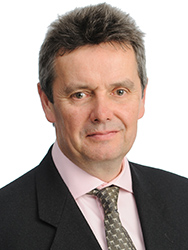David Croom-Johnson, Managing Director — AEGIS London.
There’s an old joke about the underwriting room of the future. It will have an underwriter, a computer and a dog. Why a dog? To keep the underwriter away from the computer.
I re-told this joke at the Underwriter CEO panel at this week’s Insider London conference, not in the expectation of raising a big laugh, but because like all jokes it contains a kernel of truth – namely the market’s ambivalence about the use of technology.
I think we all know that change is needed, even if we can’t agree on what and how.
The impact of the efficiency drive begun by Lloyd’s performance management director (Jon Hancock and lent weight by its new CEO John Neal’s vision have highlighted the obvious – we have to be profitable. And the changes that have been introduced have delivered a change in tone.
In 2018, the market started with plans to grow 10% and ended up at minus 3%. This is not a massive change, but it has lowered expectations and plans will not be as bullish this year. The reality is that if market players can’t turn a poor portfolio around, then more people will be out of a job. We’ve been too protective of people and classes and that’s something that has to change.
The future is data and analysis
I am frustrated when people talk about technology as disruptive. There’s no value in disruption for its own sake. It’s not about disruption, it’s about enabling.
AEGIS London’s digital platform OPAL enables access by customers from all around the world.
We have produced c.40,000 quotes in 18 months; bound 9,000 risks that we don’t touch. Average risk values are under $100k and premiums sub $10k – mostly deductible buy-backs in the SME arena. We will add more products and this strategic development project gives us energy, hope and optimism. We are doing this ourselves – enabling from within, rather than disrupting or being disrupted.
If we look more broadly to technology initiatives within the market, I think we should be optimistic, and I include PPL within that. However market modernisation turns out, the key is the customer experience should be right and that the platform adds value.
Looking ahead, I can see company platforms morphing into hubs – like Trade Ed for example. AEGIS London will react with our pricing if hubs reduce costs. We want to be efficient and improve the customer experience.
Underwriters will be different
The rise of technology is going to change how we work. The underwriting room will be smaller in ten years, but it will still be there! There will always be a need for face-to-face discussions and a rapid answer.
But we also want underwriters out in the real world – finding seams of gold, portfolios of business that we can understand and write well. It will be about understanding the client better, using knowledge better.
We have been weak at harnessing the information and the talent that we’ve got. We’ve allowed the brokers to lead in this area. So, I welcome change – the march of the analysts, data scientists and the heady world of AI – it will help us do better to harness the skills and knowledge we have.
Ambivalence about technology, like every dog, has had its day.
David Croom-Johnson was speaking to the Insider London conference on 7 February 2019.

